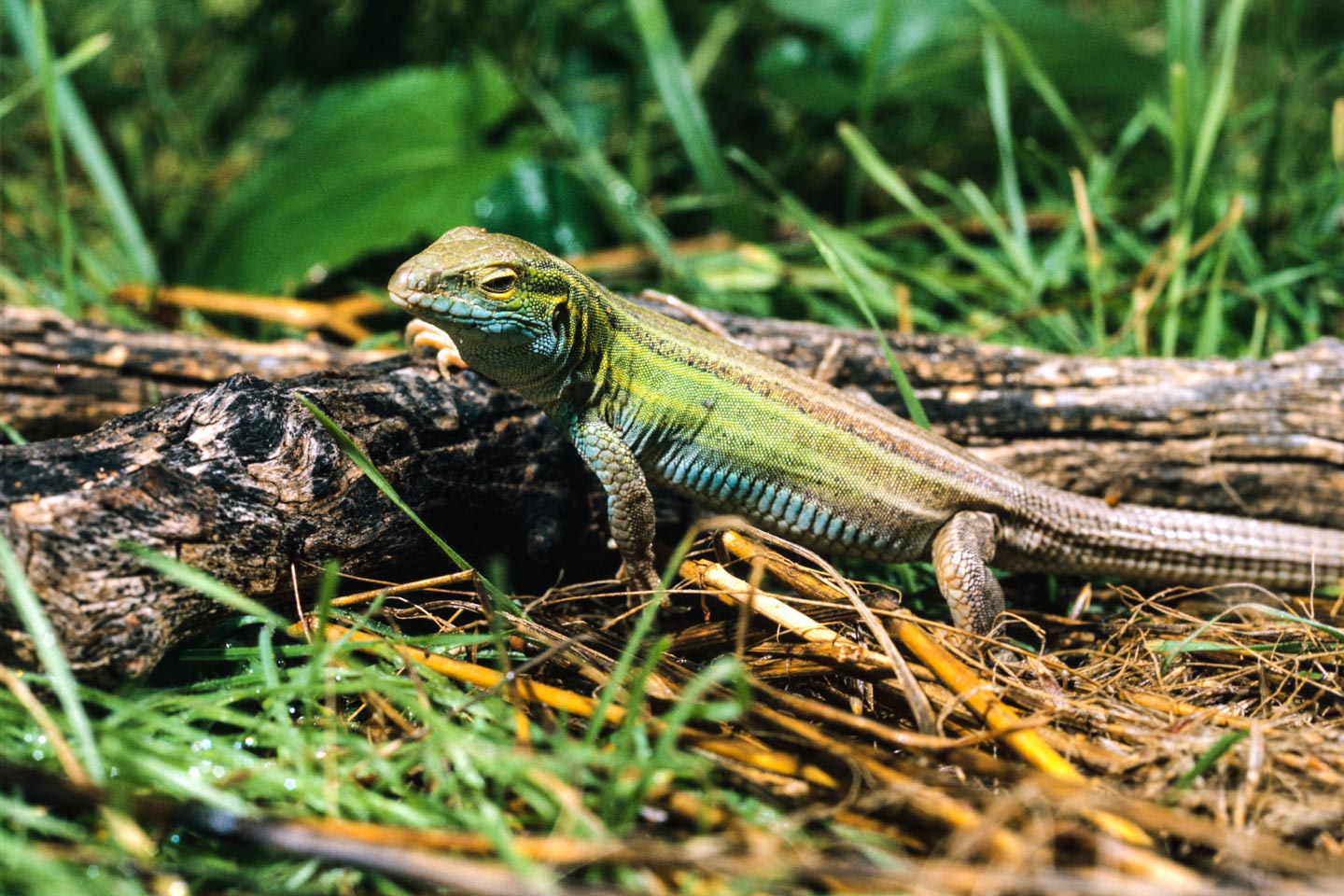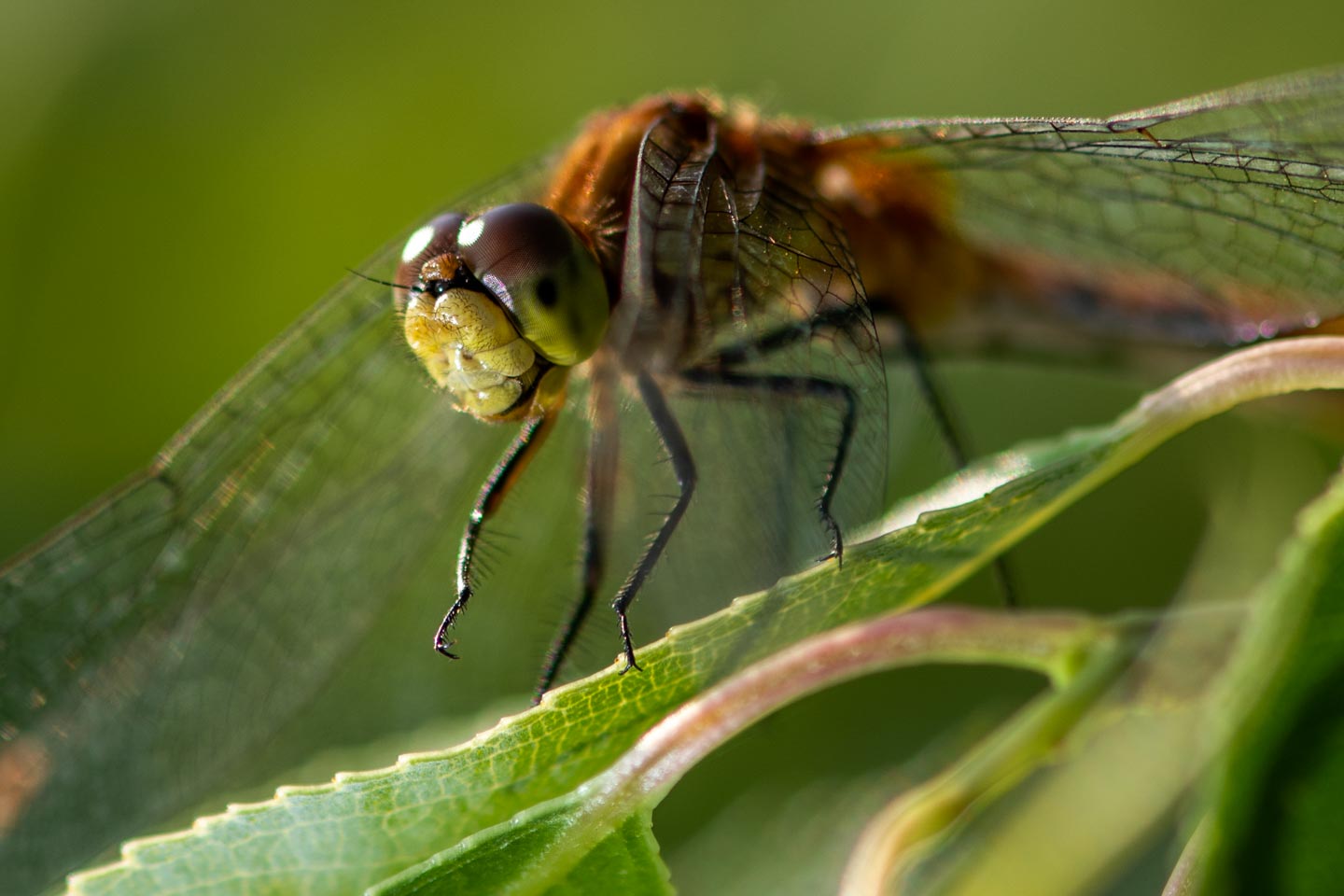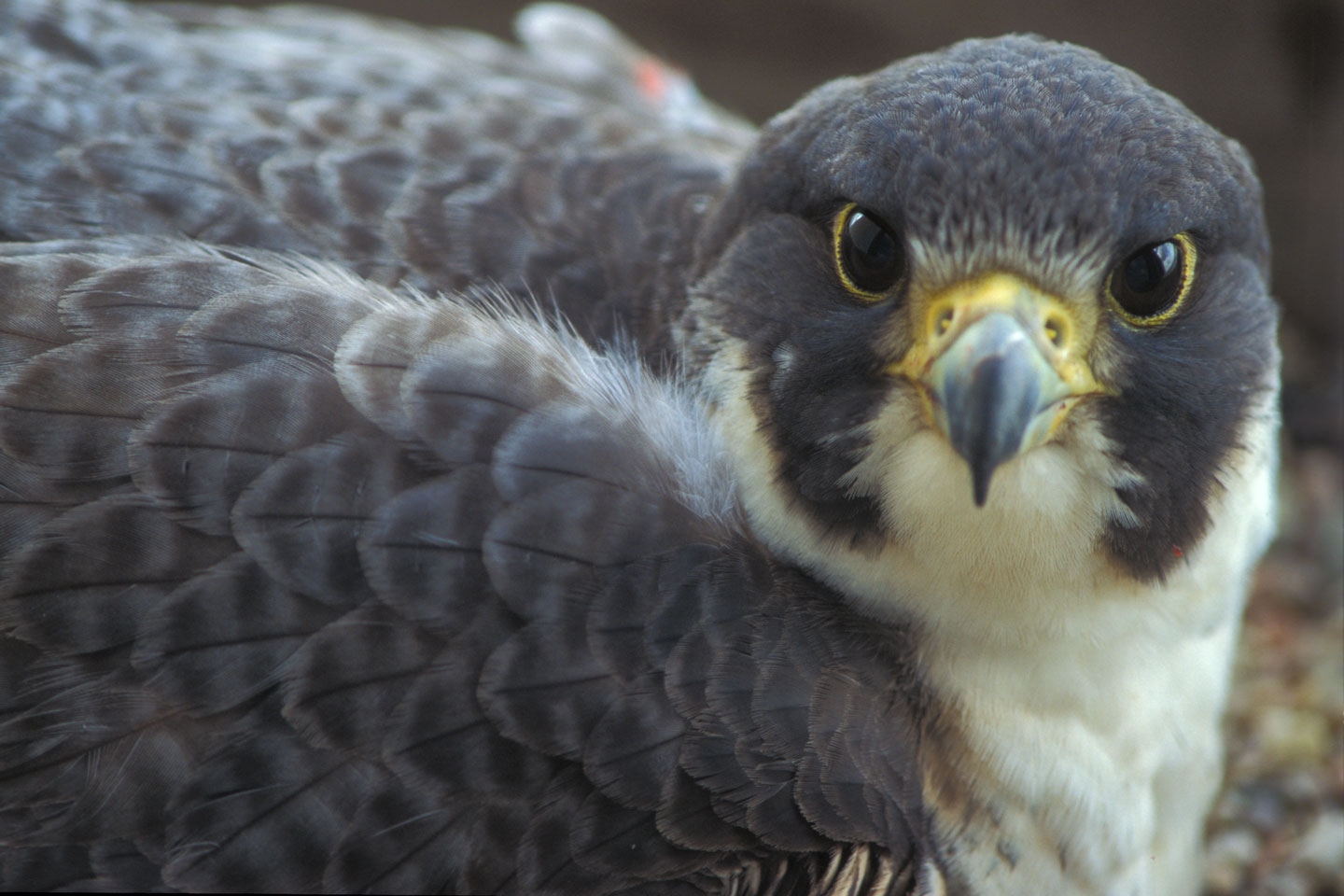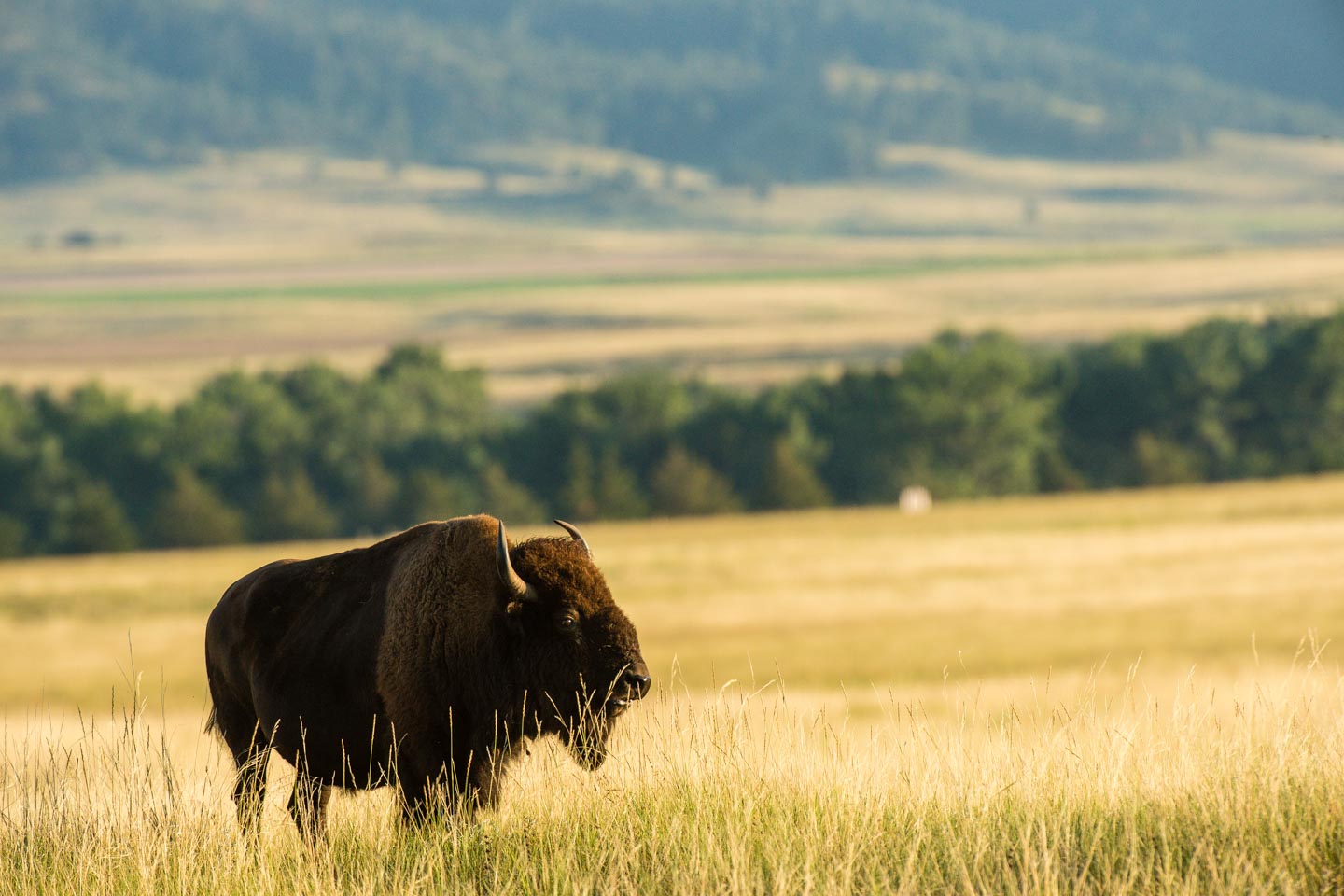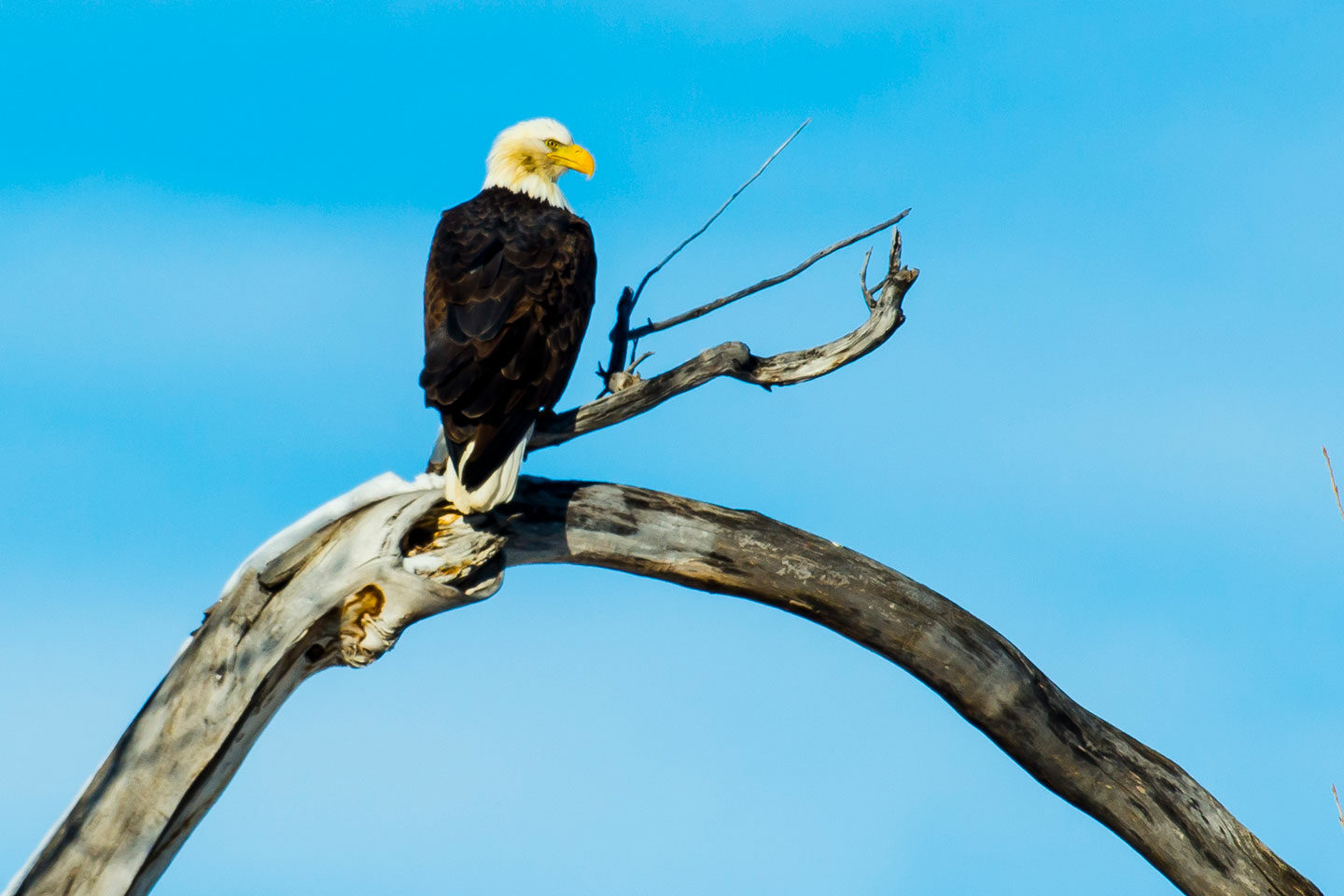Amphibians
What is an amphibian?
Amphibians include animals such as frogs, toads, salamanders, newts and caecilians. Nebraska is home to 11 species of frogs and toads and two species of salamanders. There are no native newts or caecilians to Nebraska. Amphibians can be found in any area of the state where there is water, even in the more arid region of western Nebraska. Frogs, toads and salamanders may look and behave very differently from each other, but they have a few common characteristics.
Amphibians are vertebrates
It’s sometimes hard to believe amphibians have bones, but they do. Frogs, toads and salamanders have internal skeletons made up of many interconnected bones and cartilage. Their bones are very thin and lightweight because they are made for swimming and jumping long distances. Their backbone is even heavily arched to accommodate the hunched appearance seen in frogs and toads.
They have moist skin
If you have ever touched a frog, toad or salamander you know they are slimy and wet all of the time. Their skin is often moist with mucus, which helps them from drying out. Many amphibians like frogs and salamanders have smooth skin, but most toads have bumpy bodies with raised glands. Some toads can even produce a foul-tasting secretion from these glands to deter predators from eating them. Amphibians also rely on skin-surface respiration, meaning they breathe and absorb water through their skin. Because of their special skin, amphibians require very specific living environments. Too much sun can damage their skin, too much wind can dry them out. As a result, amphibians are normally the first group of animals to die when a habitat is contaminated or disturbed. This is the main reason that half of all frog species are in danger of extinction.
Amphibians lead a “double life”
The word amphibian comes from a Greek word meaning “double life.” These animals start out as aquatic larvae, then move into a terrestrial (land) or semi-terrestrial adult stage in a process known as metamorphosis. Frogs and toads hatch from eggs as tadpoles with internal gills and specialized mouthparts for grazing on algae. As they grow, the tadpoles develop limbs, absorb their tails, develop mouths for a more carnivorous lifestyle, lose their gills, and develop lungs to prepare for life on land.
Amphibian eggs are gelatinous
All amphibians in Nebraska will return to aquatic habitats to breed during late winter, spring and summer months. These animals, depending on the species, will produce gelatinous, or jelly-like eggs, either in clusters (frogs), long strings (toads) or individual eggs (salamanders). Unlike other vertebrates, amphibians do not lay amniotic eggs so they must lay their eggs in water, so they don’t dry out. The jelly-like substance offers protection from predators and helps keep the eggs moist.
They’re ectotherms
Being an ectotherm is just a fancy way of saying an animal is cold-blooded, An ectotherm is an animal that cannot make its own body heat. Instead, the animal will rely on the sun, or their surroundings to warm up instead of producing it internally.
Why should we care about amphibians?
Frogs, toads and salamanders are often considered slimy and sometimes even gross. However, they are a critical part of the ecosystem as both predator and prey. They provide food for everything from snakes to raptors. They, in turn, eat insect pests, benefitting the agriculture industry and even human health — they eat a TON of mosquitos. Due to their moist and permeable skin, amphibians are very vulnerable to drought and polluted areas. This unfortunate trait makes them exceptional indicators of ecosystem health. When water ecosystems are healthy, they provide habitat for amphibians and contribute billions of dollars to the economy by supporting outdoor recreation, hunting and fishing.
Frog and toad species
Nebraska is home to eleven species of frogs and toads and two species of salamanders, each with unique characteristics, habits, habitats and food sources.
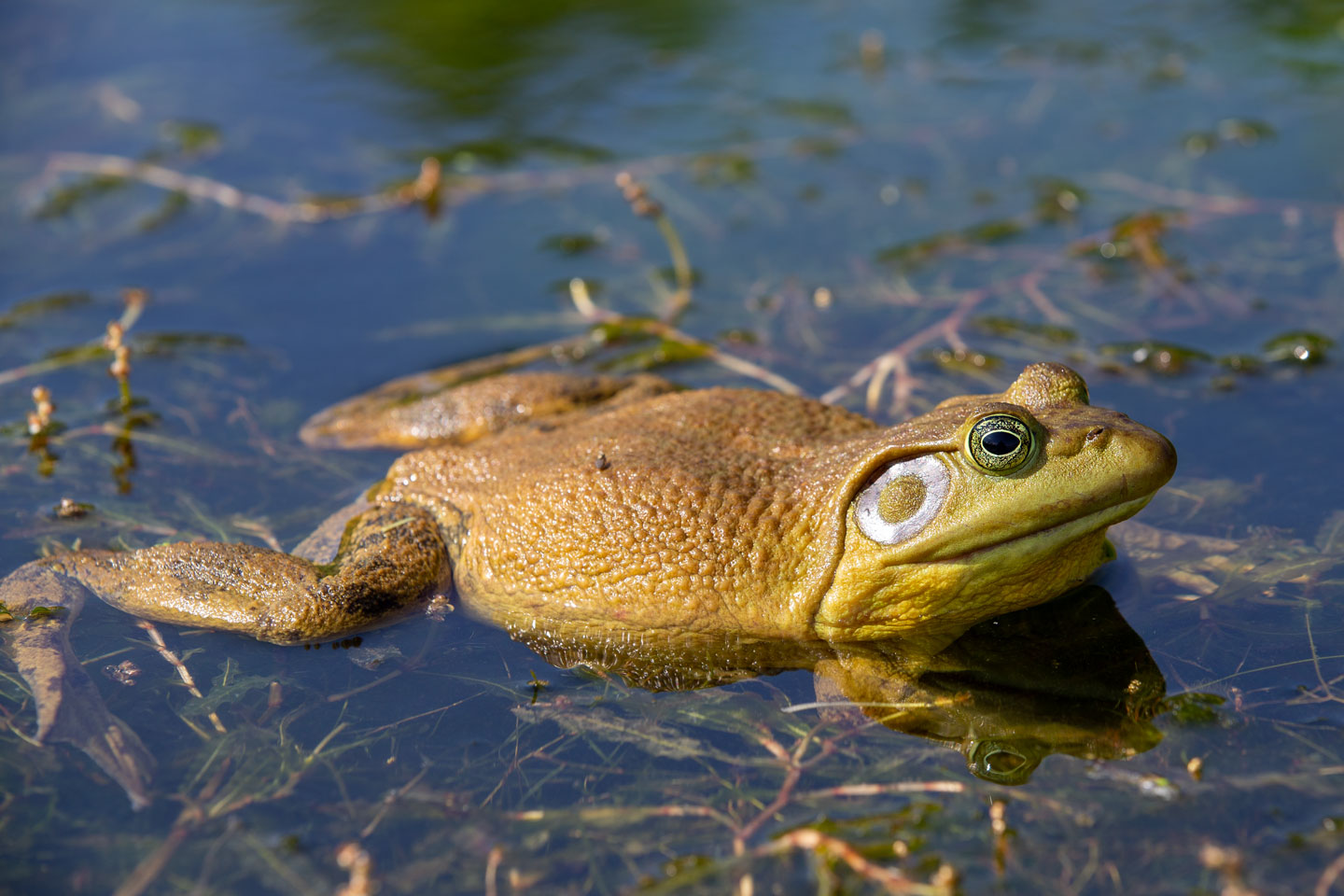
Physical description
The bullfrog is the largest frog species in Nebraska. It is mostly a green frog with occasional reddish-brown to black mottling. The green color can vary from olive green to almost a lime green. The tympanum is extremely large and located right behind the eyes.
Size
An adult bullfrog can reach between 5-7 inches and occasionally larger.
Habitat
This frog can be found in any permanent body of water. It can survive in ponds and lakes with or without fish. Shallow water along shores is their preferred habitat for foraging. They also can leave the water and make extensive migrations to different bodies of water, especially during a rainstorm.
Range in Nebraska
In Nebraska, the American bullfrog can be found throughout the entire state. Introductions and naturalizations have occurred throughout much of the western U.S. where it is considered a nuisance species.
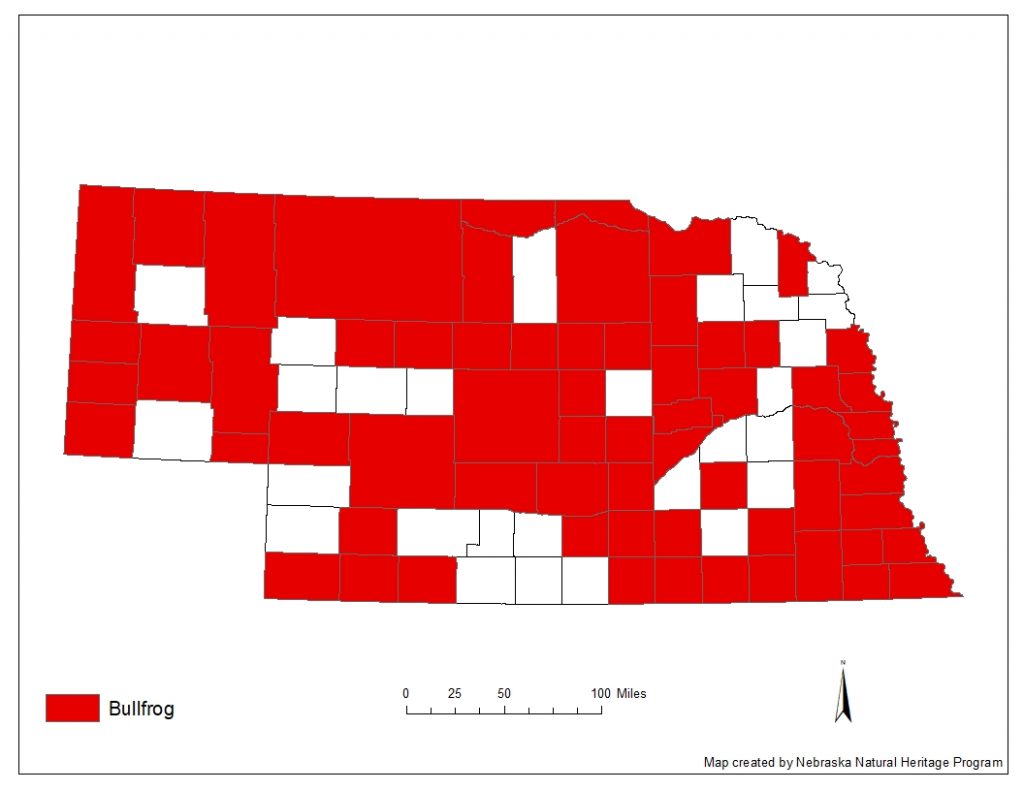
Diet
American bullfrogs are voracious predators and can eat anything they can catch, including other frogs, invertebrates, small mammals, reptiles and birds. They are only limited by the size of their mouth.
Fun Facts
- Bullfrogs can outcompete native frog species for resources or even prey on them, which has caused some frog species in the U.S. to become critically endangered.
- Bullfrog tadpoles secrete toxins from their skin that make them distasteful to predaceous fish, thus they are rarely eaten.
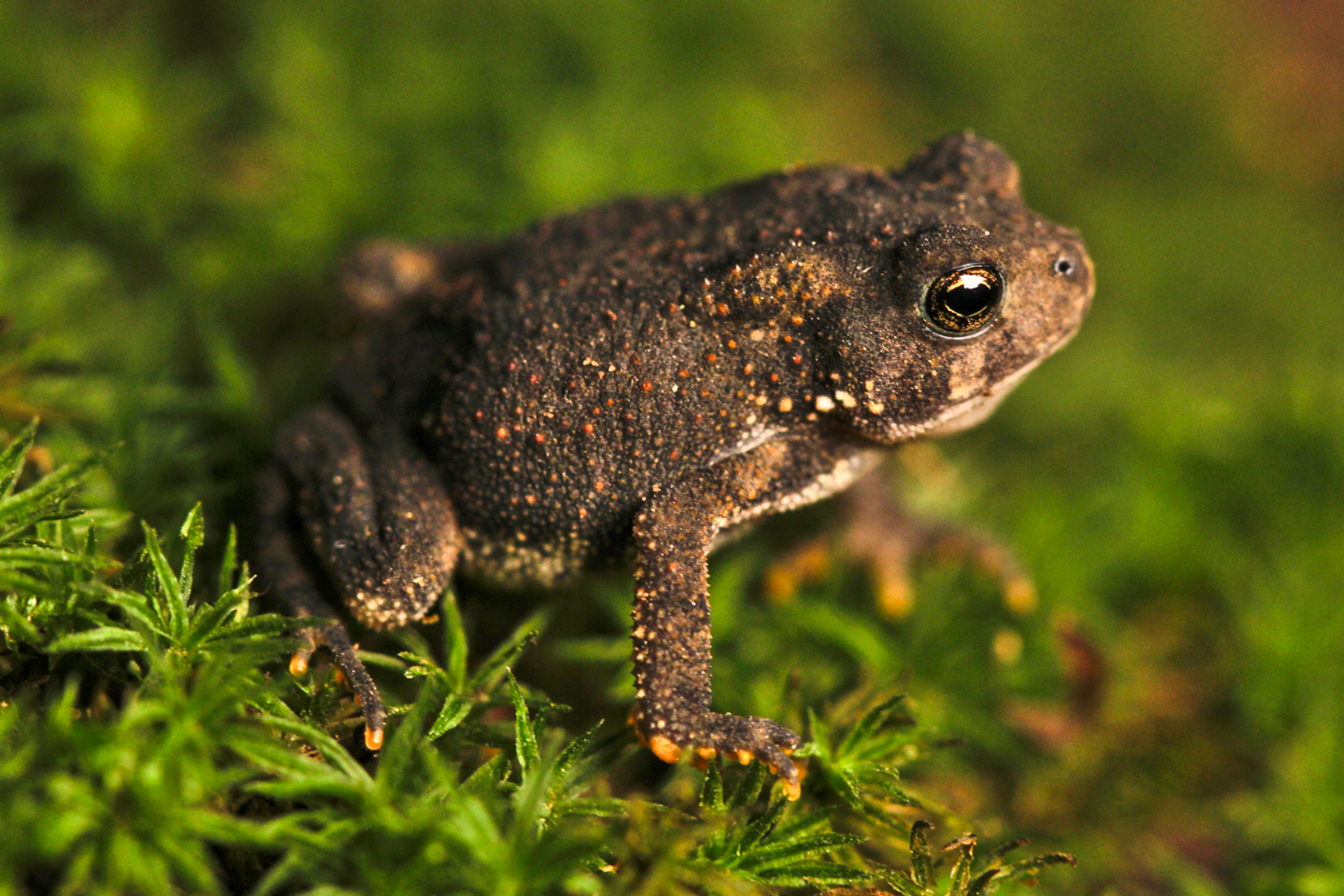
Physical description
The American toad is normally a brown, reddish-brown color to olive green. They have dark spots on the back that usually contain either one or two large warts per spot. The parotoid glands — the large glands on their back — are short, wide and kidney-shaped. The crest (top) and belly of the American toad is a creamy white color and is spotted with black.
Size
The American toad averages about 2-3.5 inches.
Habitat
In Nebraska, the American toad is found in riparian woodlands and deciduous forests along the Missouri River. For breeding, this toad will use temporary and permanent wetlands.
Range in Nebraska
In Nebraska, the American toad reaches the western edge of its range and is restricted to the eastern most counties; they typically are only seen in Washington, Douglas and Sarpy counties.
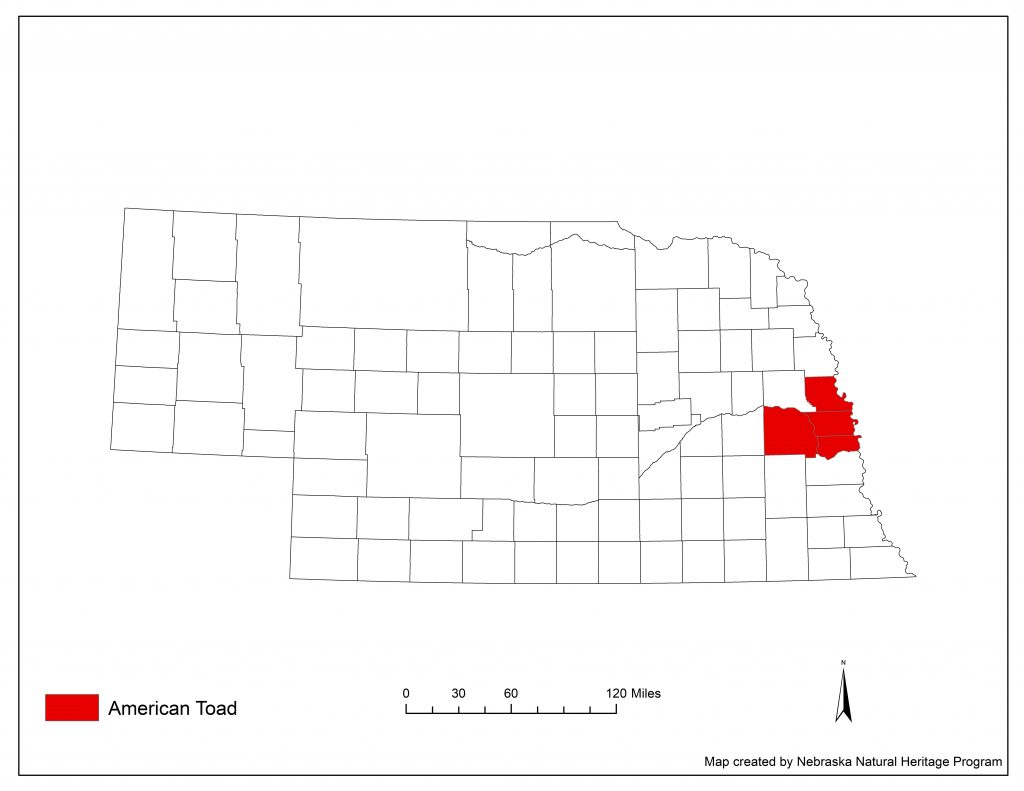
Diet
This toad, like many others, will feed primarily on arthropods, such as insects, arachnids and crustaceans.
Fun Facts
- This species is listed as a species in need of conservation in Nebraska due to its limited distribution in the state.
- The voice of the American toad is a long, musical trill that lasts about 30 seconds.
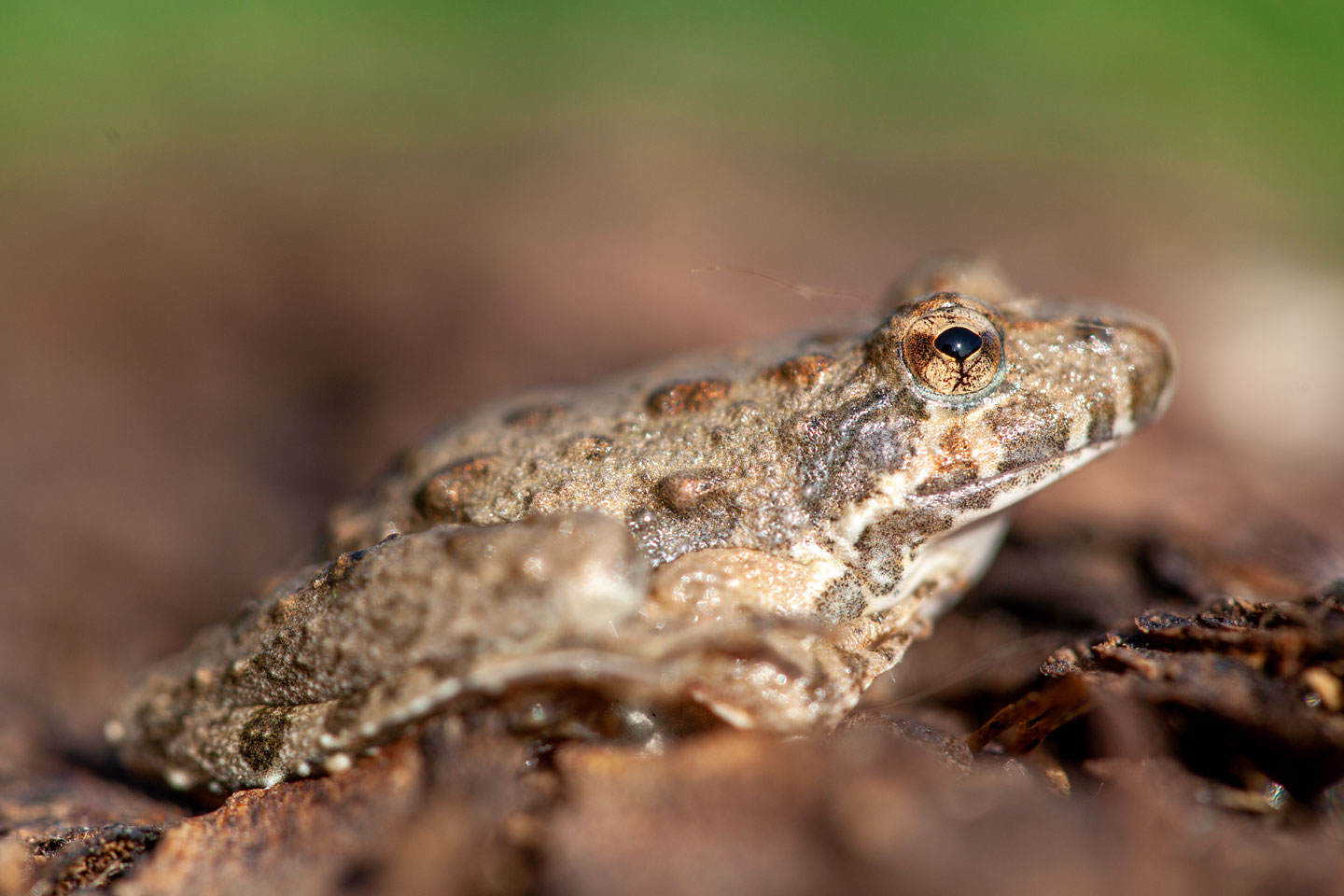
Physical description
The Blanchard’s cricket frog is one of Nebraska’s smaller frogs with fully webbed hind feet, a warty appearance on its back and a color that is normally a reddish-brown to cream or olive green. A dark triangle shape will occur between the eyes on the head. The underside of this frog is normally white, sometimes with speckling. This frog exhibits a variety of colors and patterns even in Nebraska.
Size
The Blanchard’s cricket frog rarely exceeds 2 inches in length.
Habitat
This frog is common along edges of both temporary and permanent bodies of water. They prefer areas with abundant vegetation where they can hide from predators. During the fall months, the cricket frog is commonly found in areas a fair distance from water around the limestone edges of Thayer, Jefferson and Gage counties.
Range in Nebraska
In Nebraska, the Blanchard’s cricket frog is found in the eastern two-thirds of the state along all the major streams and their tributaries.
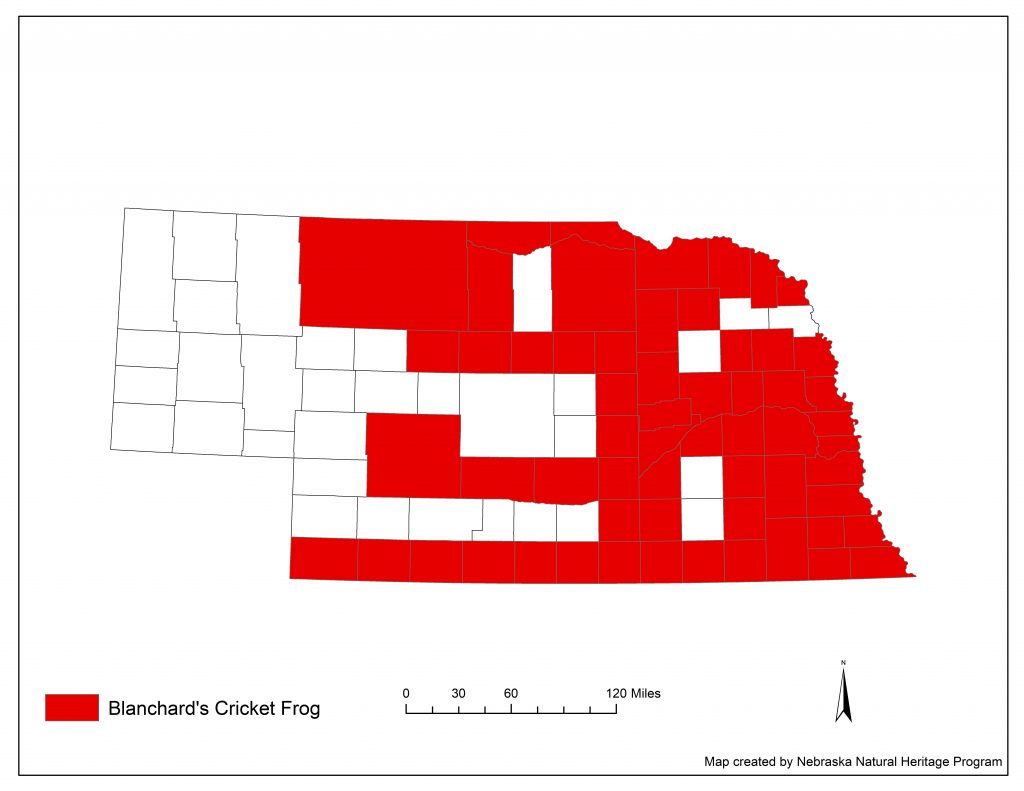
Diet
This frog will eat a variety of terrestrial insects.
Fun Facts
- The Blanchard’s cricket frog is a member of the tree frog family but is predominantly a ground-dweller.
- This frog will make a noise similar to two small marbles or pebbles clicking together: “rik-rik-rik-rik-rik-rik-rik-rik”.
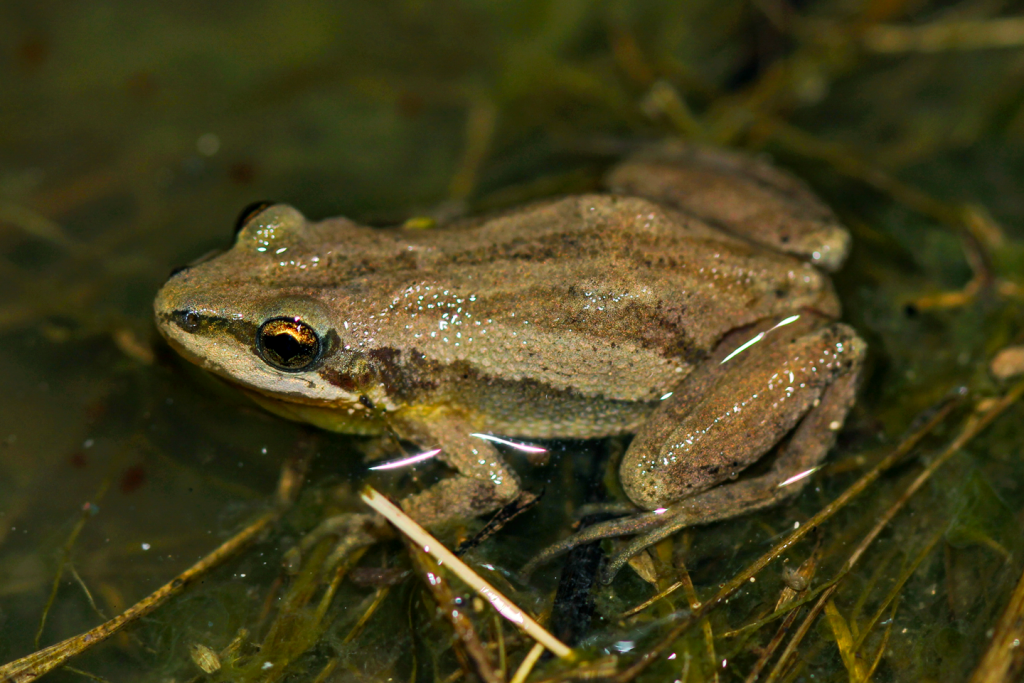
Physical description
The boreal chorus frog is a small frog normally golden brown to bronze in color with three dark green to black stripes extending down its back. Two lateral stripes extend from its nose through the eyes and down the sides. The skin is normally a granular texture and the underside is normally a creamy white.
Size
The boreal chorus frog rarely exceeds 1.3 inches in length.
Habitat
These frogs are very versatile in their habitat choices. During breeding season, they can use nearly any body of water. After the breeding season, they can be found far from water in areas from open grasslands to dense woodlands. They will take cover beneath rocks and in crayfish burrows to avoid extreme climactic conditions.
Range in Nebraska
In Nebraska, this frog is found fairly statewide.
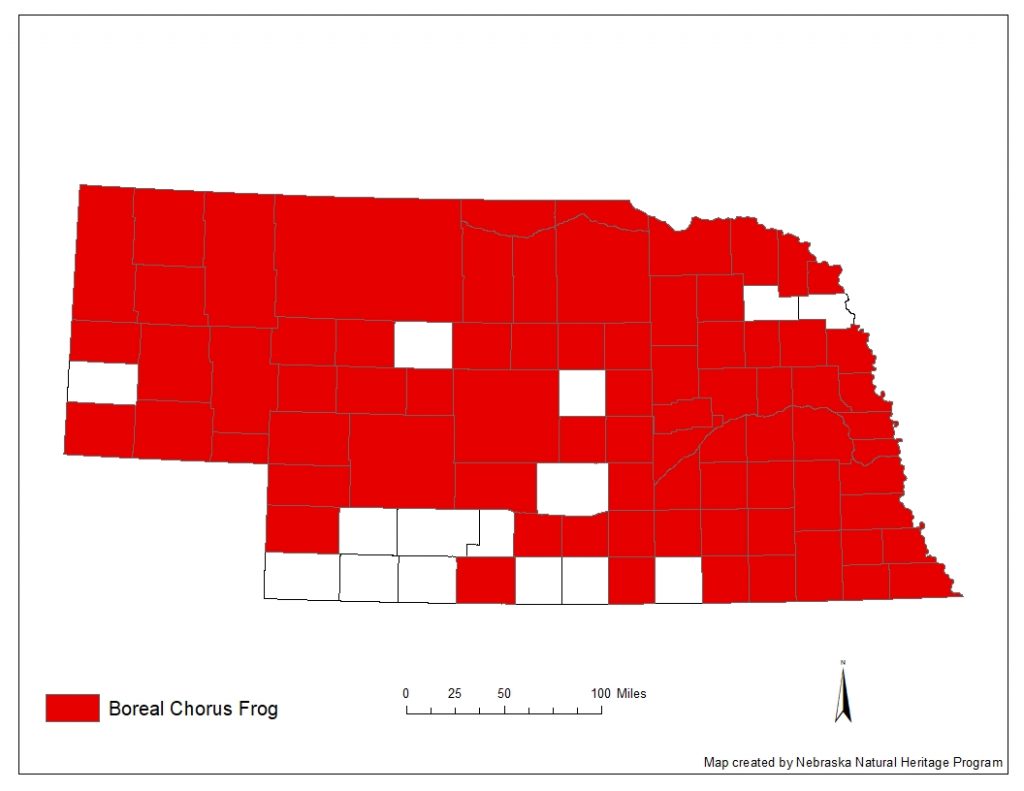
Diet
Boreal chorus frogs eat a variety of small invertebrates, especially beetles, flies, crickets, grasshoppers, ants and spiders.
Fun Facts
- These are often the first frogs to start calling in the spring, normally right after the snow melts — sometimes as early as the beginning of March.
- Their song is similar to the sound of a finger running along the tips of a fine-toothed comb.
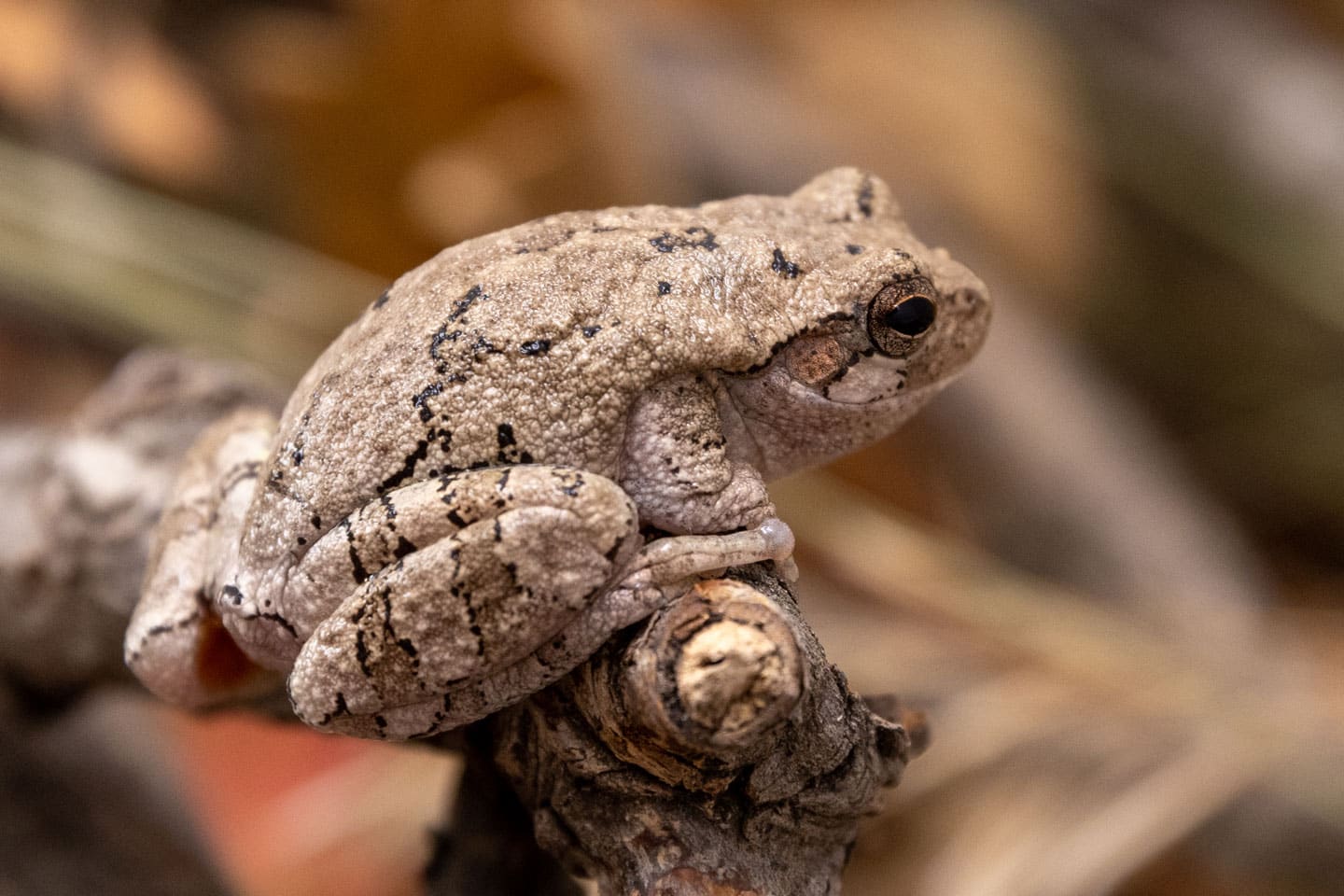
Physical description
The Cope’s gray treefrog gets its name from normally being a gray in color, but it can also be bright green, tan or light brown. This is Nebraska’s only true arboreal or tree-living frog species. It spends daylight hours sleeping on tree leaves or in holes in trunks and branches. The toes of this frog end in large sticky toe pads that allow them to cling to surfaces. They also have bright yellow-orange coloration on the inside of their thighs.
Size
The Cope’s gray treefrog adults are normally 1-2 inches in length.
Habitat
This frog species are common around riparian woodlands and oak savannas near temporary and permanent bodies of water.
Range in Nebraska
In Nebraska, the Cope’s gray treefrog is found in the southeastern counties, although there have been individuals collected in isolated areas in more northern and western counties. Their range is expected to expand as prairie streams begin to become more wooded environments.
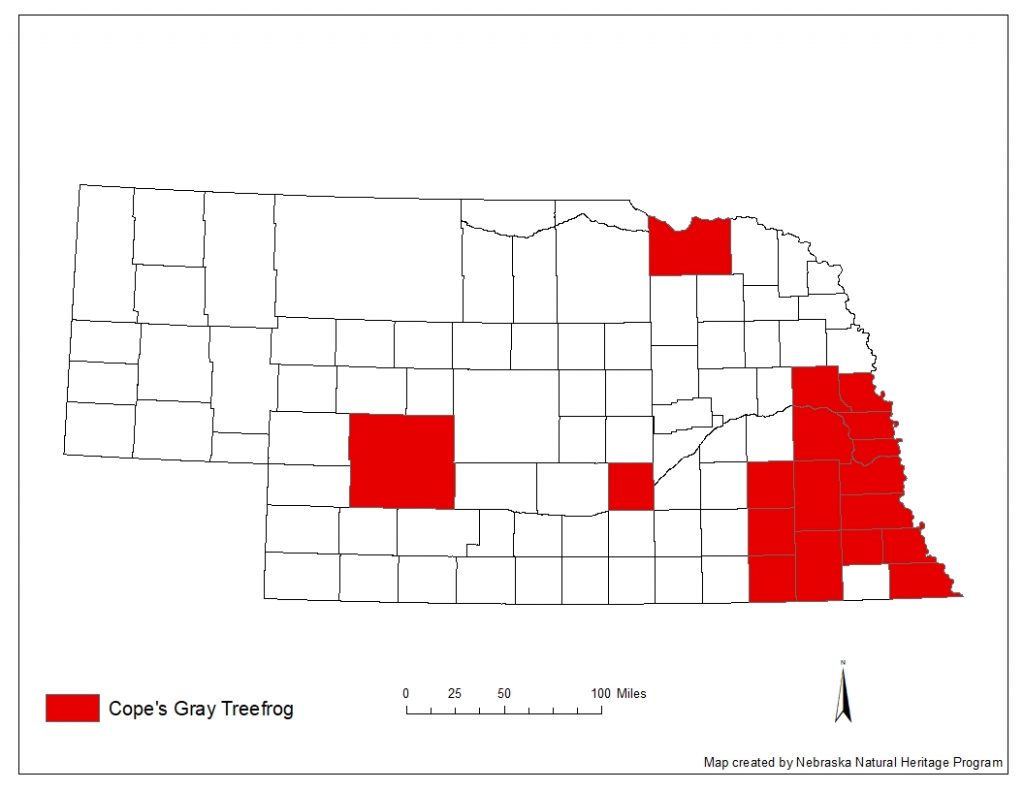
Diet
Cope’s gray treefrogs eat insects, spiders and other invertebrates.
Fun Facts
- Tadpoles of this species are easily identified by their brightly colored with red to rust-colored tails.
- The male’s call is a very short trill that lasts only a few seconds. Most people believe they are hearing a bird calling when actually it is the Cope’s gray treefrog.
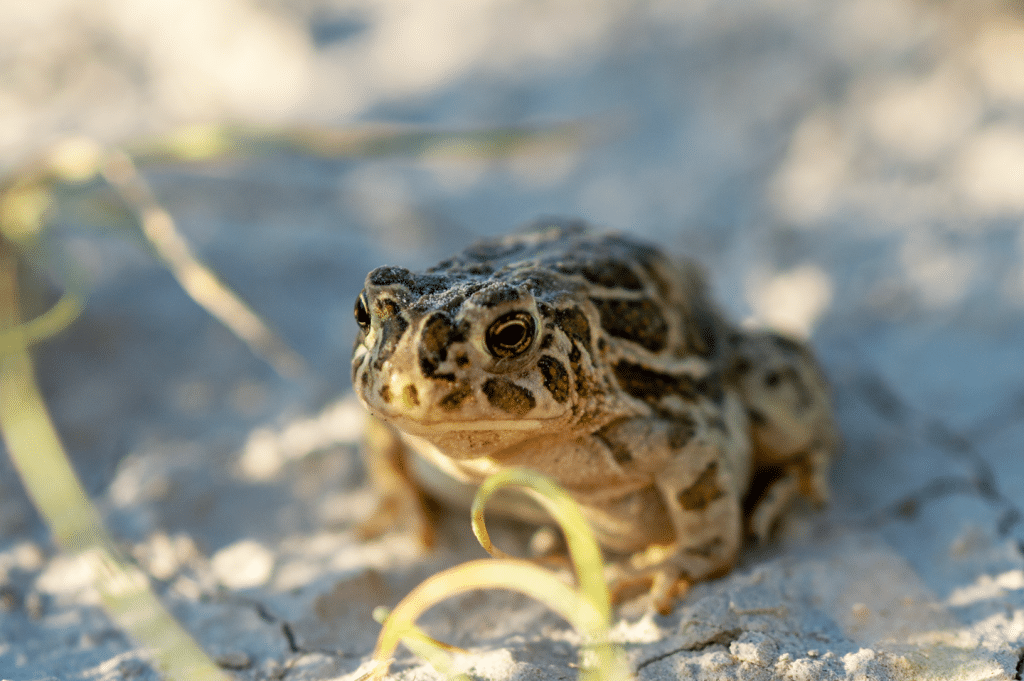
Physical description
The Great Plains toad is easily identified because it is the only toad in Nebraska that has large dark blotches on its back. These blotches are often outlined in white or cream. These toads have a ridge between their eyes, known as a large cranial crest, that joins toward the front in a “V” shape.
Size
The Great Plains toad has an average size of 3-4 inches.
Habitat
This species of toad is a true grassland inhabitant and can be found in short-, mixed- and tallgrass prairies throughout the state. They can be found in areas with permanent bodies of water, but they also are known to exist in areas where the water is seasonal or where there is no permanent body of water for miles.
Range in Nebraska
In Nebraska, the Great Plains toad is found throughout the state but are more common in the western half to two-thirds in mixed- and shortgrass prairies.
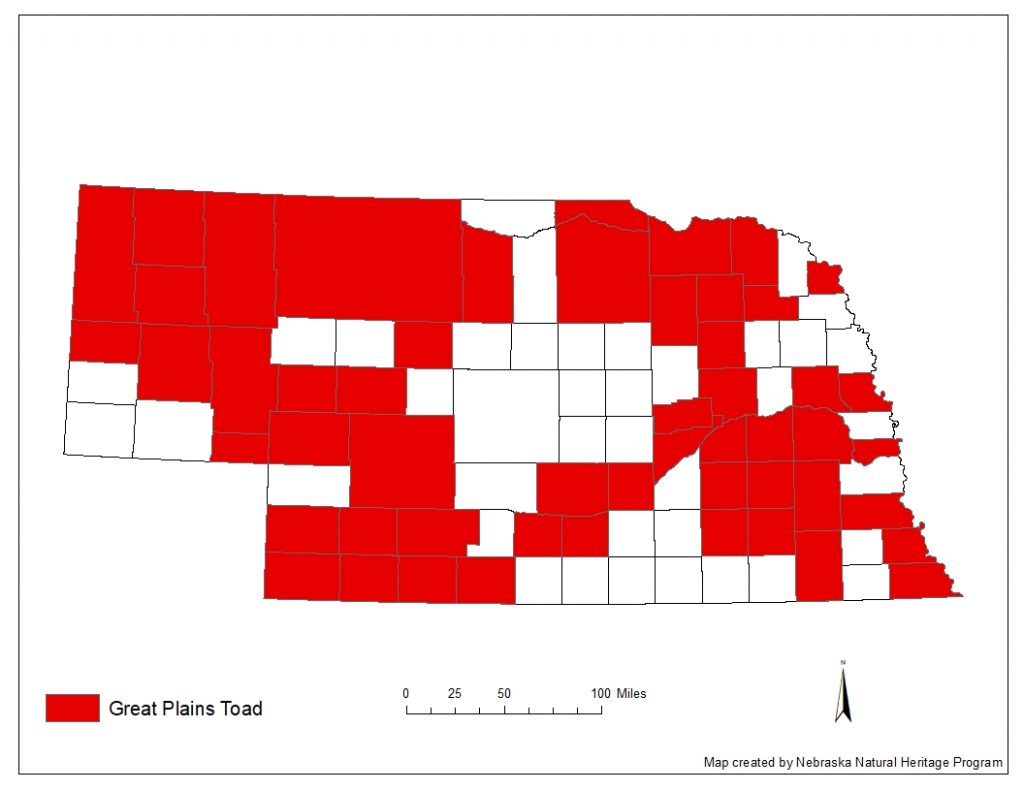
Diet
At night this toad will emerge to feed on ants, beetles and other insects.
Fun Facts
- Since these toads live in areas with potentially seasonal water, their eggs hatch and tadpoles metamorphose into toadlets in about 5 weeks.
- Great Plains toads are accomplished burrowers and will avoid extreme heat by digging into the soil.
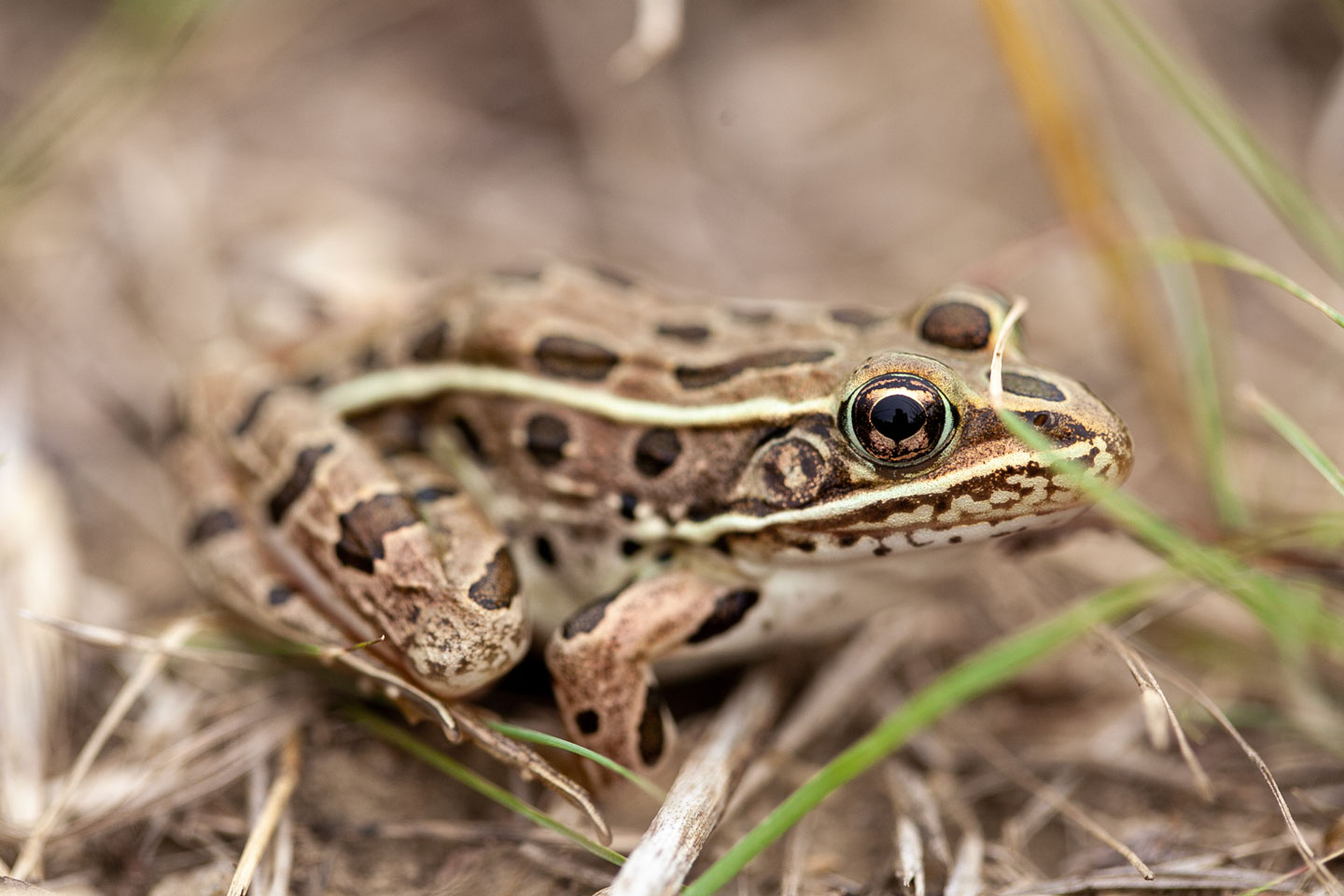
Physical description
This is Nebraska’s other spotted frog species. Normally this frog is green with some brown and gray. They have dark spots with light-colored edges or borders. They also have a dorsolateral fold or line that runs all the way down to their legs that is intact, unlike the plains leopard frog. This frog is also more slender than the plains leopard frog.
Size
An adult northern leopard frog averages between 2.5-4 inches long
Habitat
This frog is found in meadows and semi-permanent bodies of water. They also have been known to inhabit cattle stock tanks. Just like the plains leopard frog this species can wander far from water but is less tolerant of dry conditions.
Range in Nebraska
In Nebraska, this species occupies the northern half of the state above an approximate line that follows the Platte River.
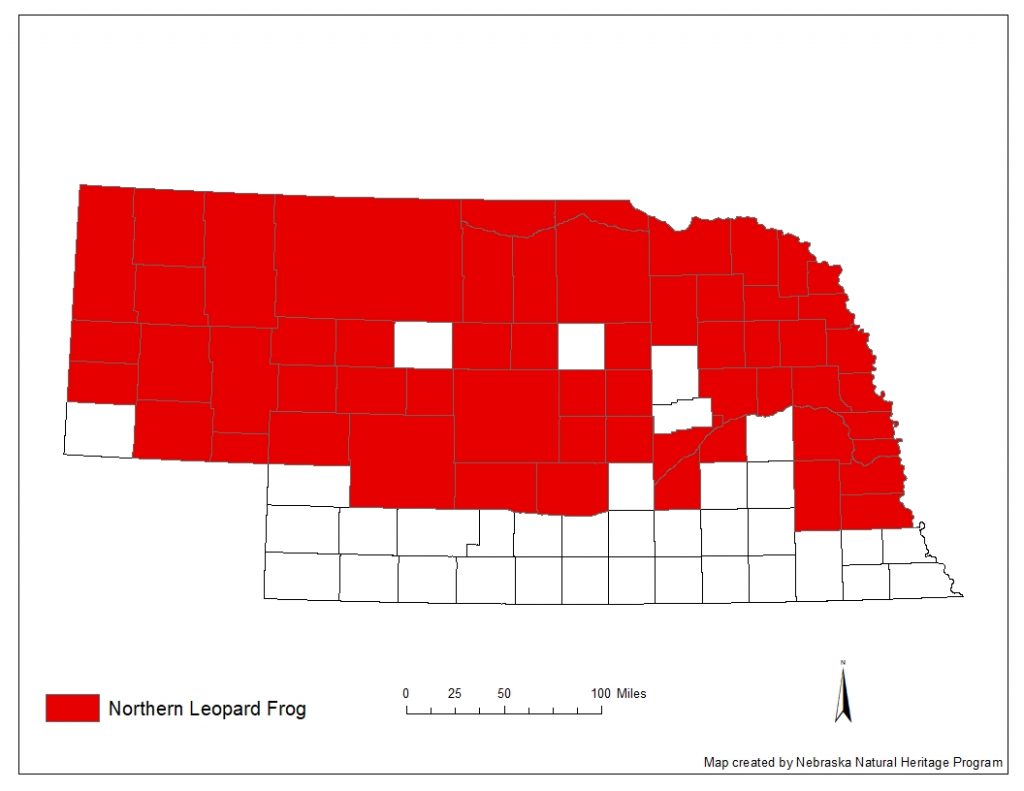
Diet
The northern leopard frog eats land-based invertebrates, such as insects, and insect larvae, spiders, slugs, snails and earthworms.
Fun Facts
- The larvae metamorphose in July and August but, in northern climates, they may spend a winter in the larvae stage before metamorphosing.
- Nebraska’s populations appear to be stable, but there is anecdotal evidence that the plains leopard frog is expanding its range in Nebraska and possibly increasing competition and hybridization with the northern leopard frog.
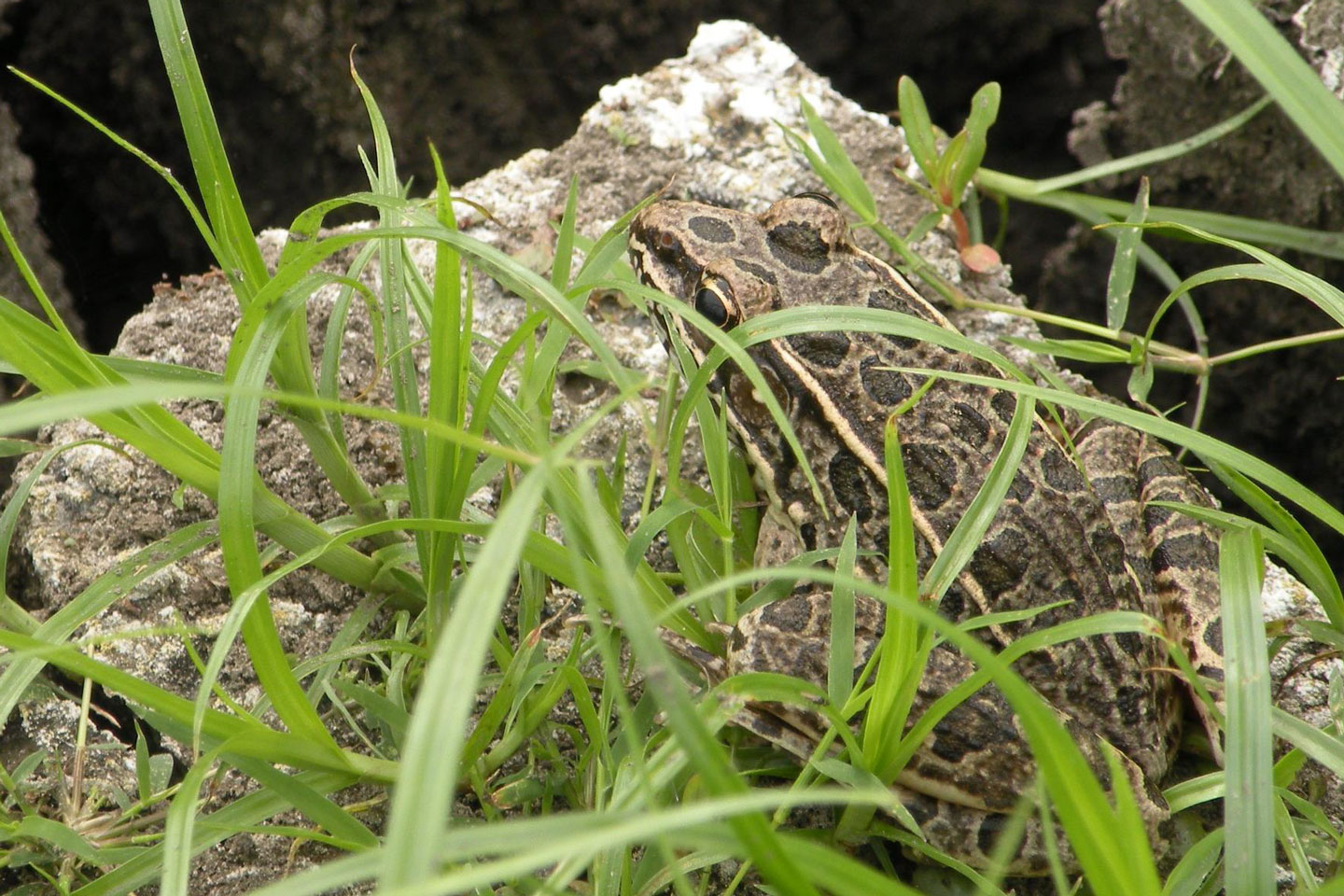
Physical description
The plains leopard frog is one of two spotted frogs in Nebraska. This frog has a tan to grayish-brown color with dark rounded spots. This species also has a prominent dorsolateral fold or line located on each side of the back and breaks up into smaller more lines towards the legs. The tympanum usually has a white spot in the center; this is the easiest way to tell the difference between the two types of leopard frogs in Nebraska.
Size
An adult plains leopard frog reaches an average of 2.7-4 inches in length.
Habitat
You can find a plains leopard frog in ponds, streams, lakes, rivers and any other suitable body of water. This species is known to wander far from water as long as there are moist conditions. This is a true grassland species using its spots to camouflage in the vegetation.
Range in Nebraska
In Nebraska, the plains leopard frog is found in the eastern two-thirds of the state.
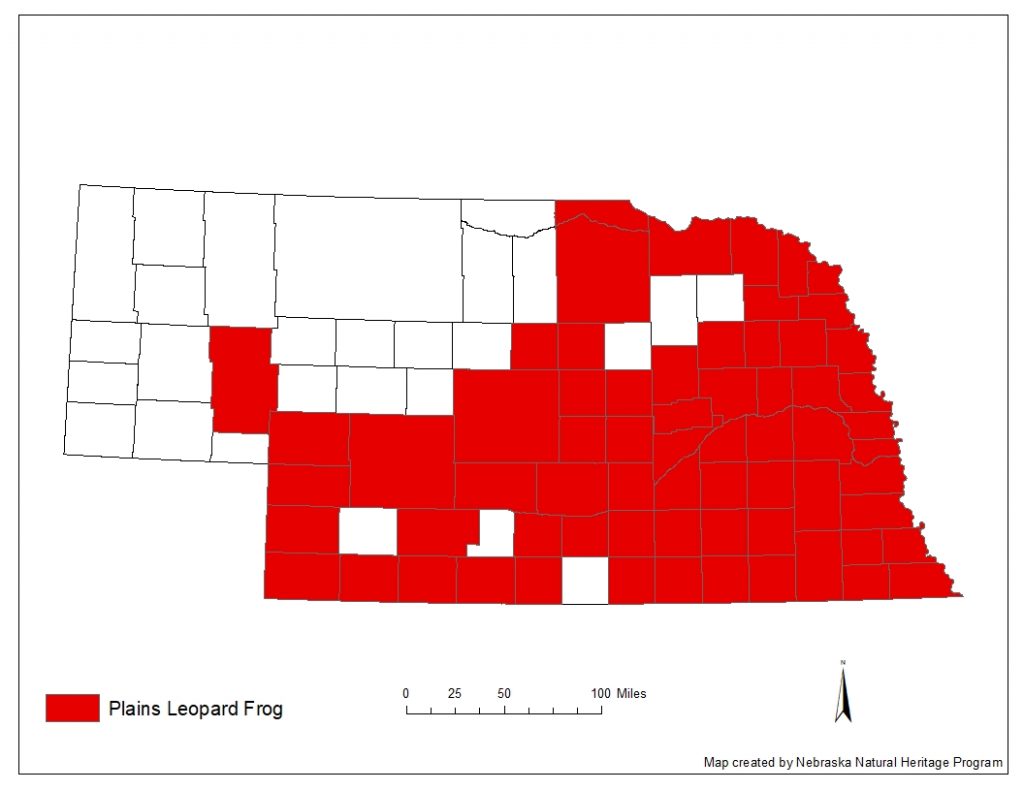
Diet
Their food consists of arthropods, such as insects and other invertebrates.
Fun Facts
- When startled, these frogs will make huge leaps into the water while squeaking out an escape sound. Once in the water, they will take cover under vegetation or other debris until it is safe to resurface.
- The male’s advertisement call sounds like a series of chucks that end in a slightly longer chuck (chuck-chuck-chu-u-u-ck).
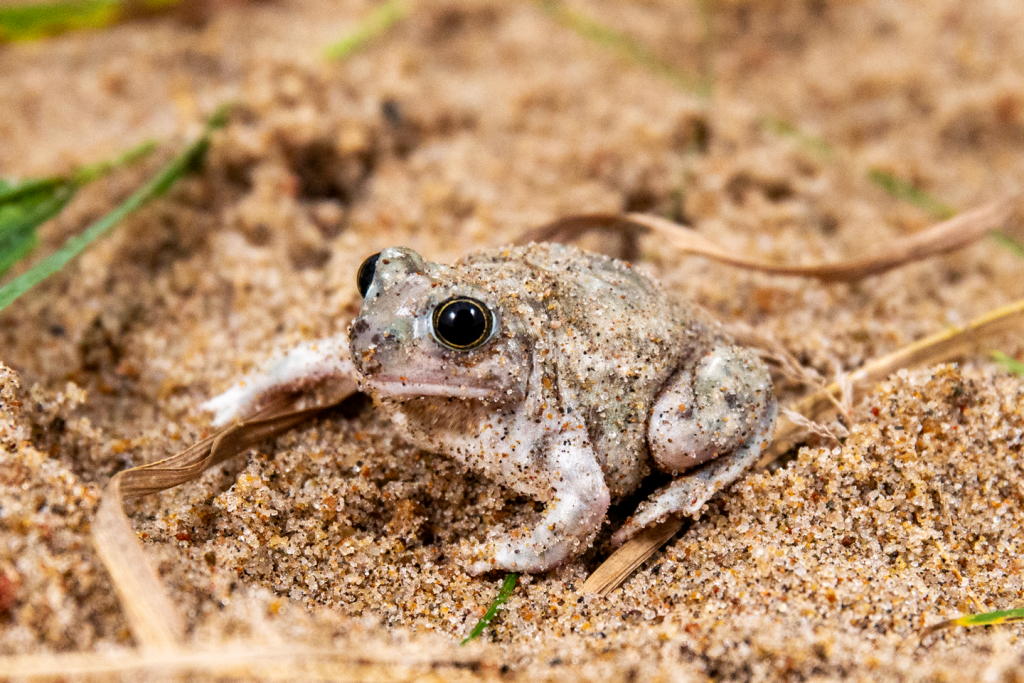
Physical description
Although often referred to as the “Spadefoot Toad,” this species is not a “true” toad because it lacks parotoid glands and the skin is relatively smooth and moist. This is the only amphibian in Nebraska to have vertically elliptical pupils. The distinguishing characteristic of this amphibian is the “spade” located on the hind feet. This allows spadefoots to dig themselves into loose sandy soils.
Size
An adult spadefoot is normally about 2 inches in length.
Habitat
The plains spadefoot is a grassland species and can be found near any grassland or prairie habitat, even those areas that receive very little precipitation. Loose soil is preferred and permanent bodies of water are not necessary.
Range in Nebraska
In Nebraska, this species it is known from the entire state with the exception of the extreme southeastern corner.
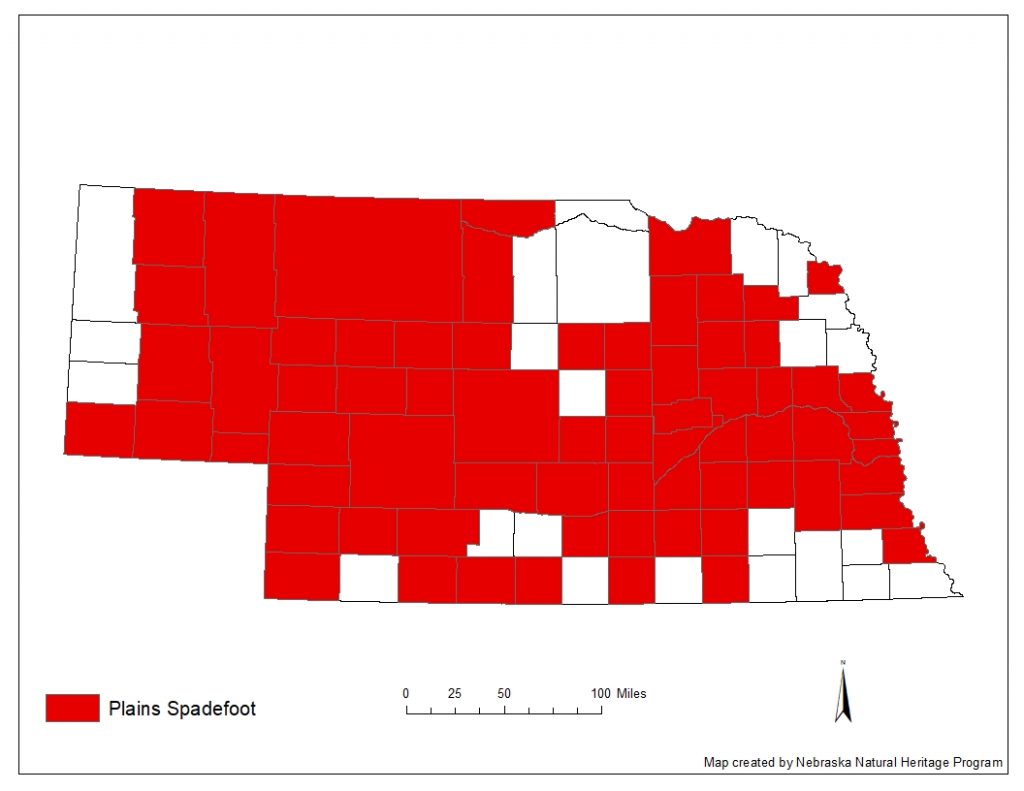
Diet
The plains spadefoot toad consumes earthworms and a variety of insects.
Fun Facts
- There are two types of tadpoles that hatch from spadefoot toads: one type is herbivorous and another is carnivorous. This strategy ensures that even if the pond dries too quickly for vegetation and algae to grow, a portion of the offspring will still be able to feed, grow and rapidly change into adults.
- Plains spadefoots are considered explosive breeders. During and after heavy rainfalls from late April through July, they will gather in large pools to call and breed.
Physical description
This little “toad” is probably Nebraska’s oddest-looking frog. It is also one of the rarest. This is the only species of frog or toad in Nebraska that lacks an external eardrum. They are fairly flat and normally a gray to olive green color with a slightly lighter belly. There is no pattern on this animal although there may be dark specks on the sides. The nose comes to a point and there is skin that appears “folded” around the neck area.
Size
An adult western narrow-mouthed toad rarely exceeds 1.5 inches long.
Habitat
This frog prefers moist grasslands with limestone rocky outcrops. These animals also use burrows excavated by mammals, arthropods and other animals.
Range in Nebraska
In Nebraska, the western narrow-mouthed toad is known from multiple areas in the extreme portion of Gage and Webster counties, but they are probably more widespread than this.
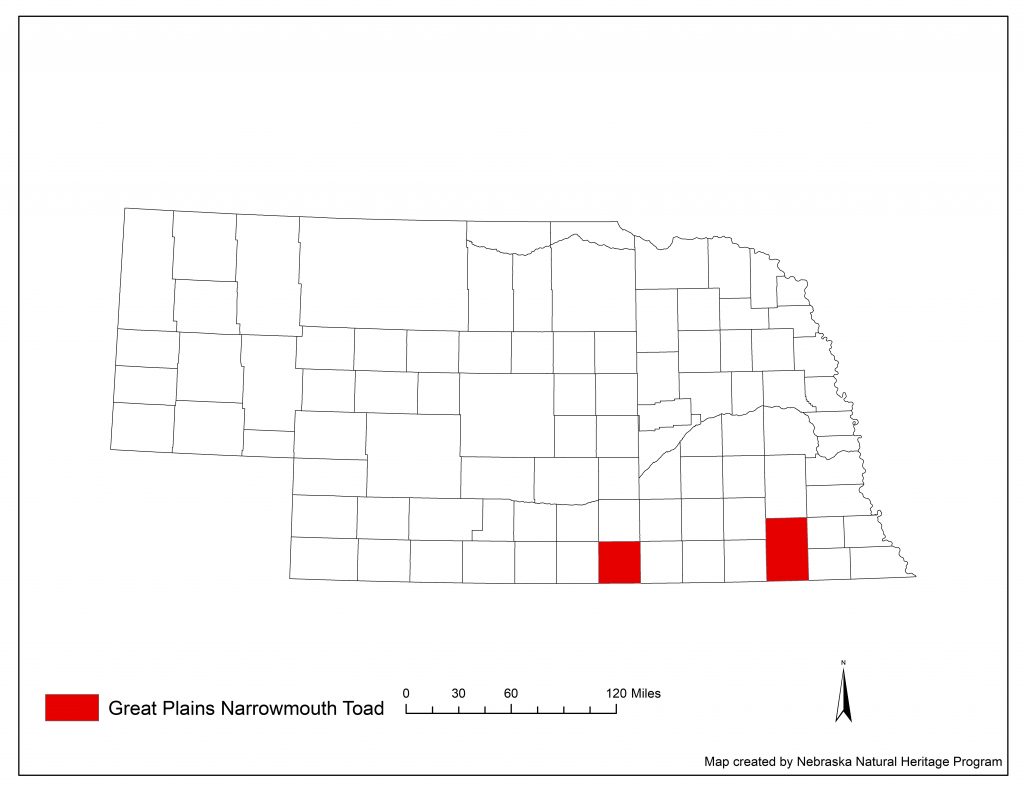
Diet
The narrow-mouthed toad is a specialist that feeds almost exclusively on ants.
Fun Facts
- The western narrow-mouthed toad has a relatively toxic skin due to their diet of ants. This helps them avoid being eaten by many other predators much larger than themselves.
- Breeding season for this frog normally begins in late April when spring rains cue them to exit their winter shelters.
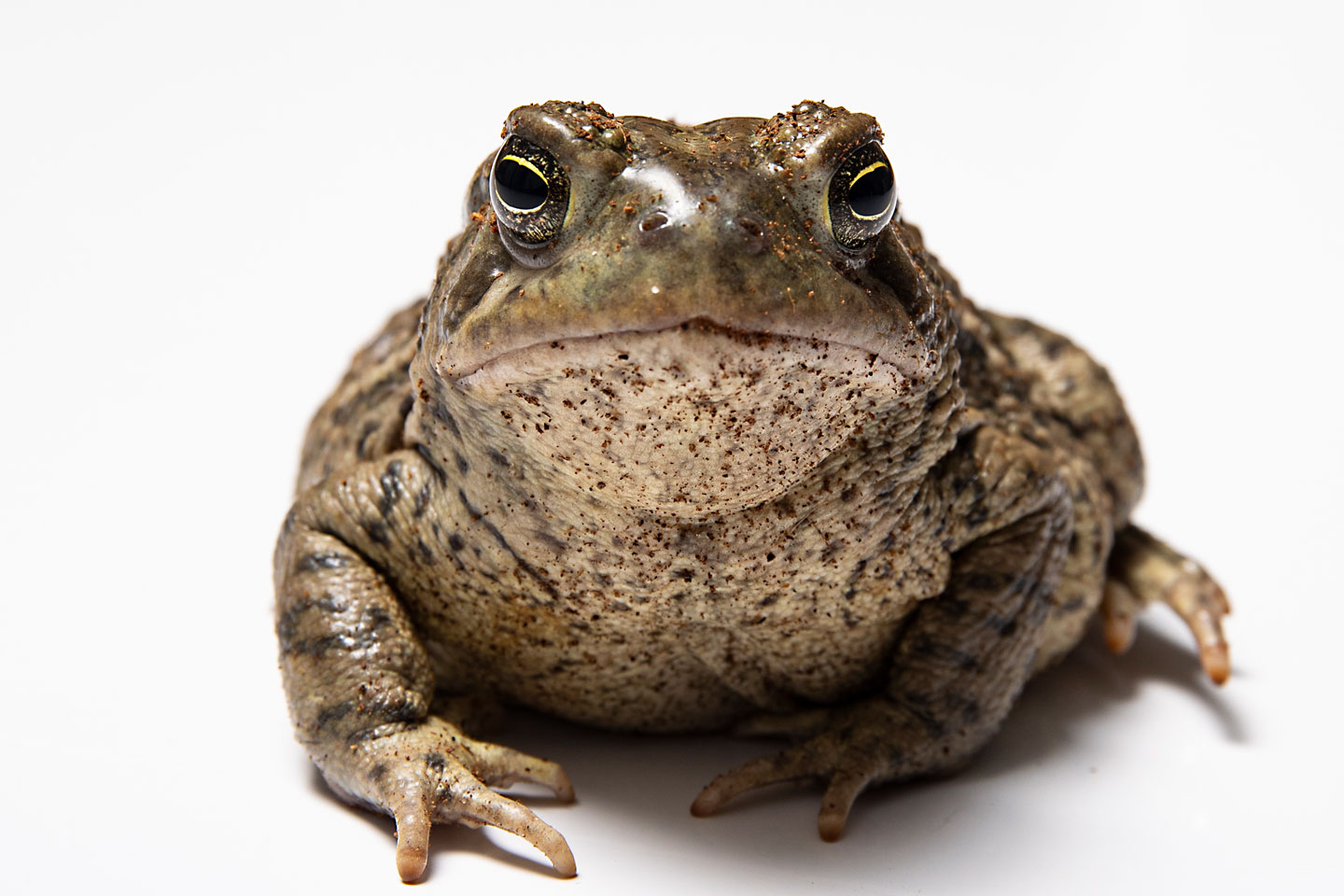
Physical description
The Woodhouse’s toad is often a light gray, tan, brown or yellowish in color. They are very similar in appearance to the American toad but have narrower parotoid glands. These toads also have a distinguishing white stripe down the center of their back. The underside of the toad is white except for a single small black spot on its chest.
Size
The Woodhouse’s toad averages between 2.5-4 inches.
Habitat
Woodhouse’s toads can occupy a variety of habitats including woodland edges, grasslands, agricultural fields, parks, golf courses, and even suburban and urban backyards and gardens.
Range in Nebraska
In Nebraska, the Woodhouse’s toad occurs statewide and is abundant nearly everywhere it occurs.
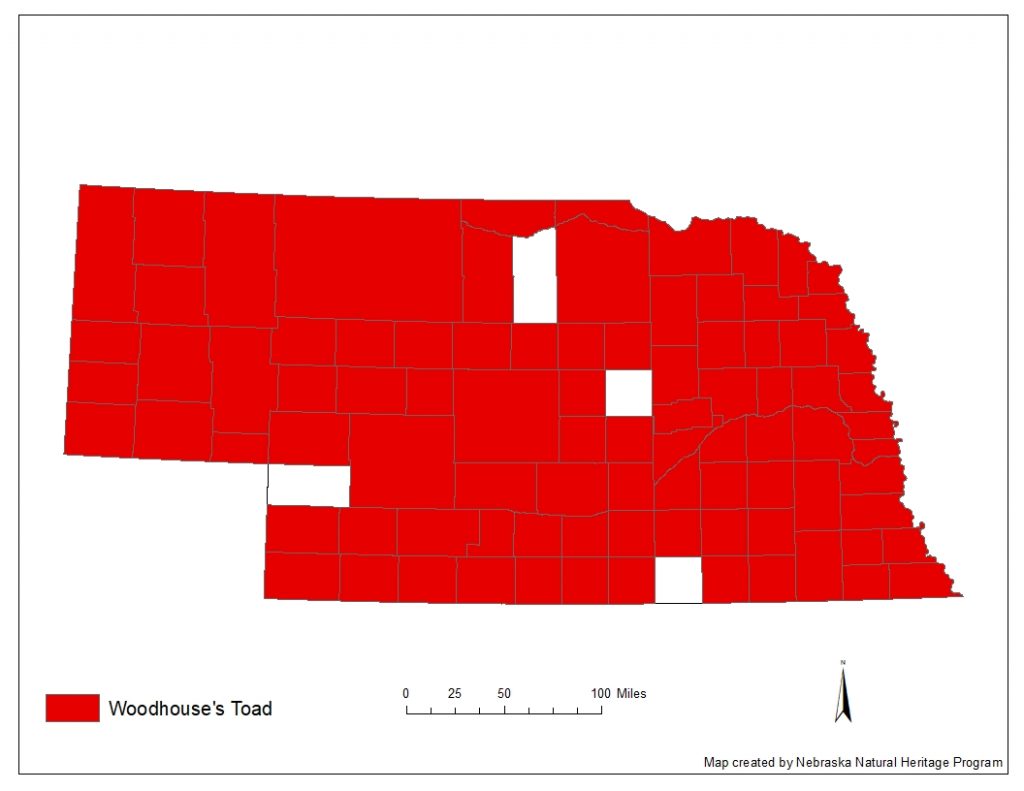
Diet
At night this toad will emerge to feed on insects and other arthropods.
Fun Facts
- The voice of a Woodhouse’s toad is a nasally “WAHHHHHHHH” sound that is similar to a sheep’s bleat and lasts only 3-4 seconds at a time.
- These are commonly encountered toads on the banks and sandbars of the Missouri, Platte, Niobrara, and Republican rivers, as well as all other streams in Nebraska.
Salamander species in Nebraska
Dive into the world of salamanders discovering what each species in Nebraska looks like, where it’s located, what it eats and other fun facts.
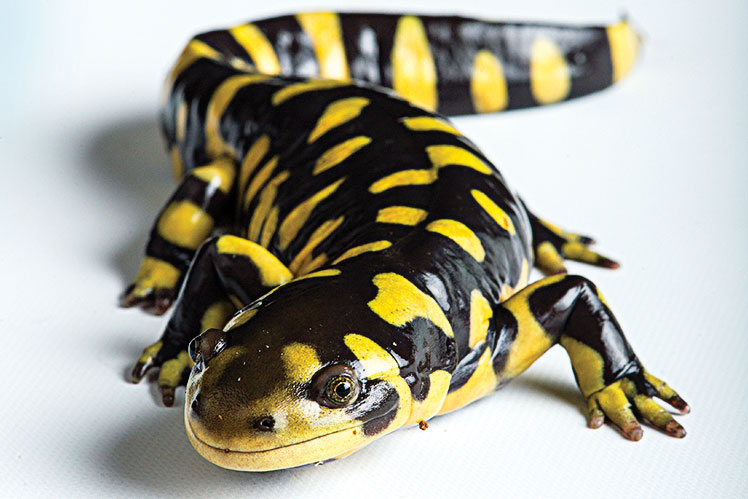
Physical description
Depending on the location in Nebraska, you will find different variants of the barred tiger salamander. In the southern portion of the state, they have clearly defined, often vibrant yellow bars, on a mostly black or very dark green or gray body. In the Sandhills and in northwestern counties, the black color is reduced and appears like a net pattern and is often olive green to pale yellow.
Size
Barred tiger salamanders average about 6-8 inches in length.
Habitat
This salamander can be found in permanent or semi-permanent bodies of water. Fishless ponds are preferred. This species is well adapted to arid grasslands of the Great Plains. In western Nebraska, they are known to take cover and shelter in prairie dog or other small mammal burrows.
Range in Nebraska
In Nebraska, this species is found statewide and is fairly common. They are regulated as a bait species.
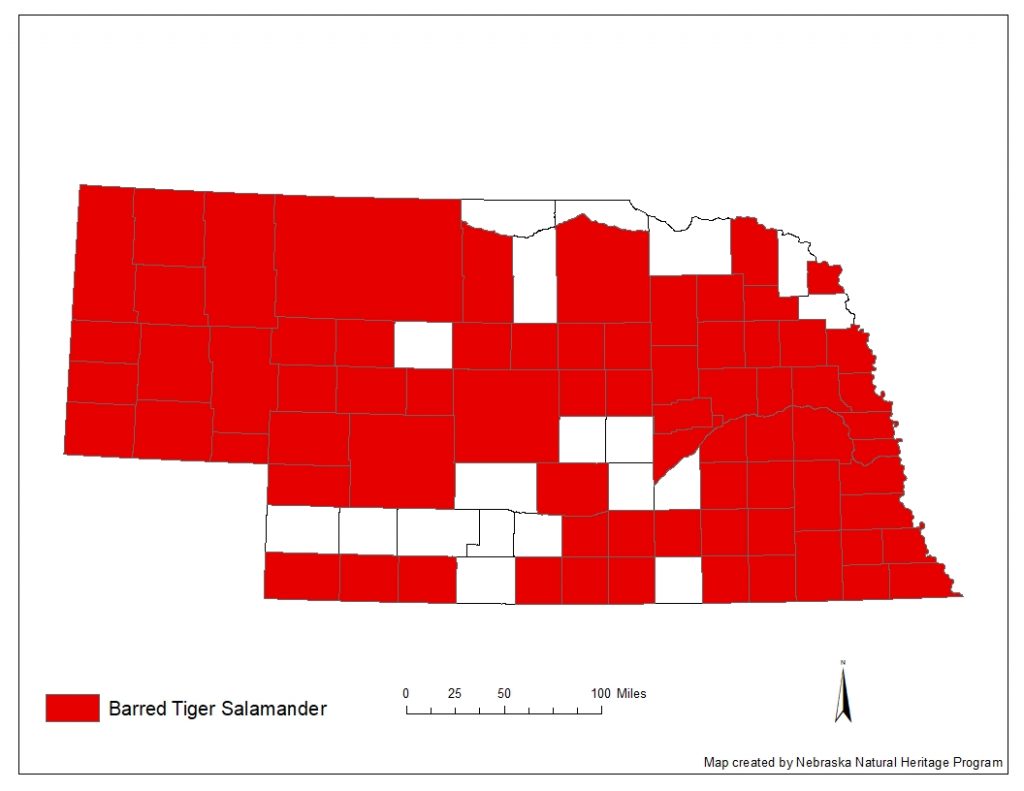
Diet
Barred tiger salamanders will eat anything they can catch, including other salamanders and larvae.
Fun Facts
- Barred tiger salamanders larvae can take two forms: typical or cannibalistic. Cannibalistic forms are easily identified by their exceptionally large body size and somewhat comically enlarged head. After hatching, they become voracious predators.
- This is a very long-lived species, sometimes living until age 20 in captivity.
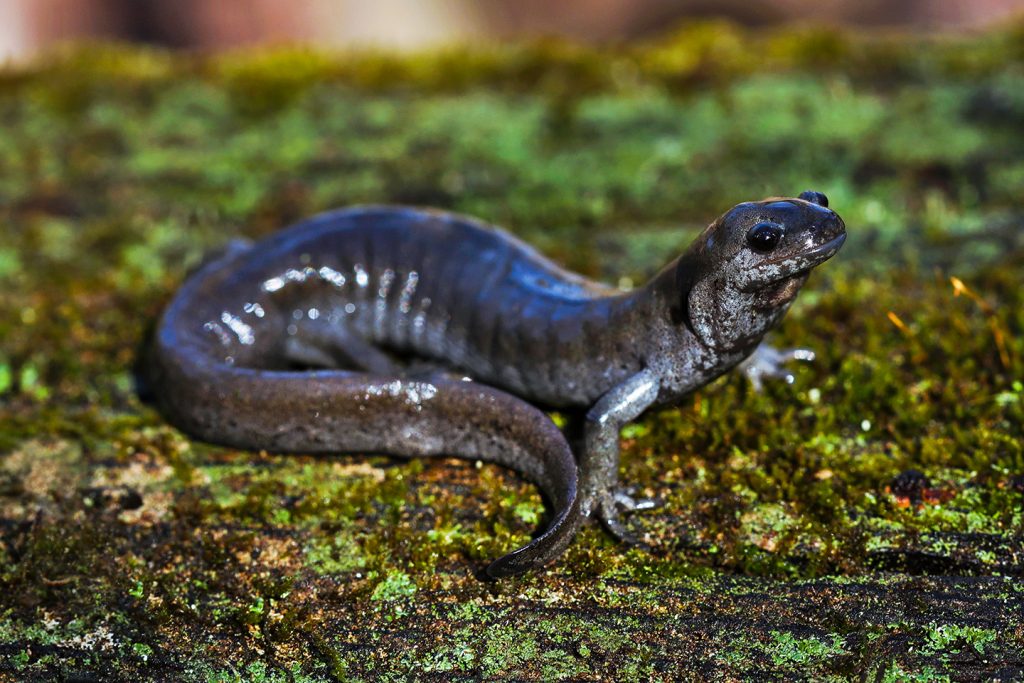
Physical description
This is Nebraska’s smallest salamander. Their color is normally olive green to brown, and many individuals are speckled with metallic gray-ish blue silver or bronze-colored flecks along the sides. The head looks disproportionately small for the body; the mouth and the lower jaw will protrude slightly past the upper jaw.
Size
The Small-Mouthed Salamanders range 4.0-5.5 inches in length.
Habitat
In its range, the small-mouthed salamander occupies a vast array of habitats from wet woodlands to wet prairies. Breeding will take place in fishless ponds, roadside ditches and semi-permanent wetlands within woodlands or woodland edges.
Range in Nebraska
In Nebraska, this species barely enters the state and is only found in a few counties in extreme southeastern Nebraska.
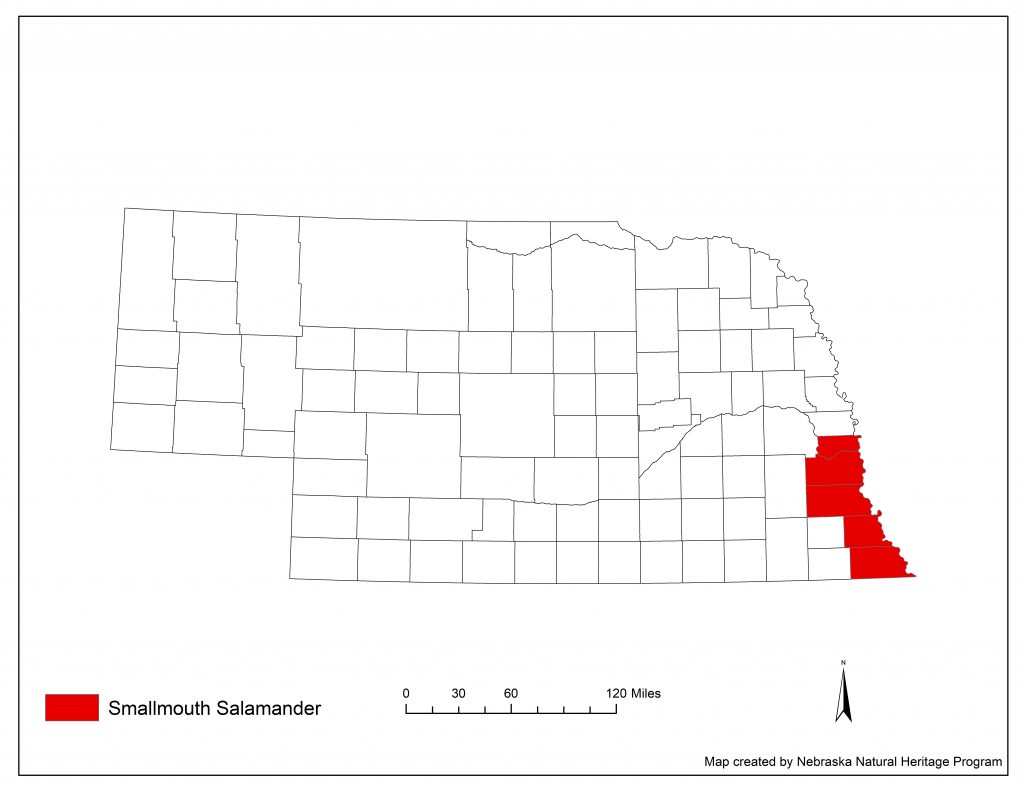
Diet
The small-mouthed salamander feeds on aquatic invertebrates, insects, worms and basically anything else it can catch.
Fun Facts
- Small-mouthed salamander larvae can be differentiated from tiger salamander larvae by their pigment.
- Females will lay hundreds of eggs either individually or in small clusters.
Related content
Learn about more of Nebraska’s wildlife and our conservation efforts.

